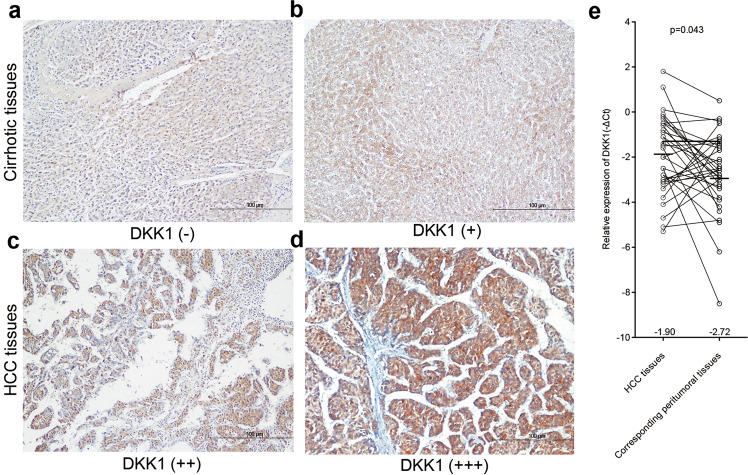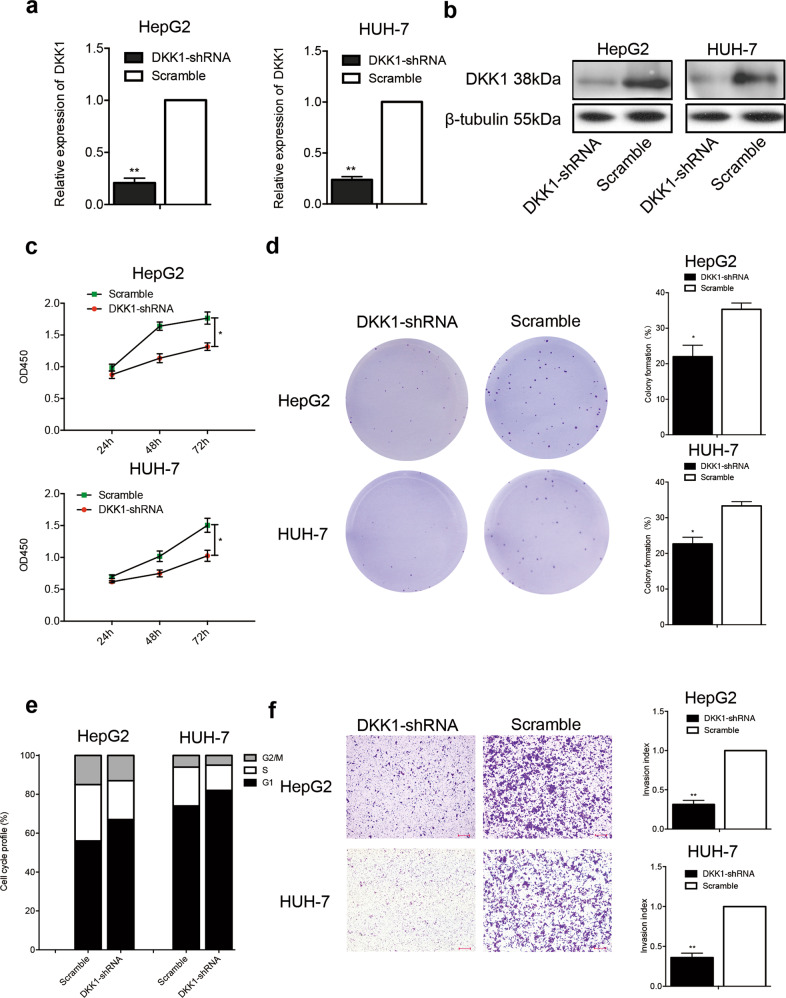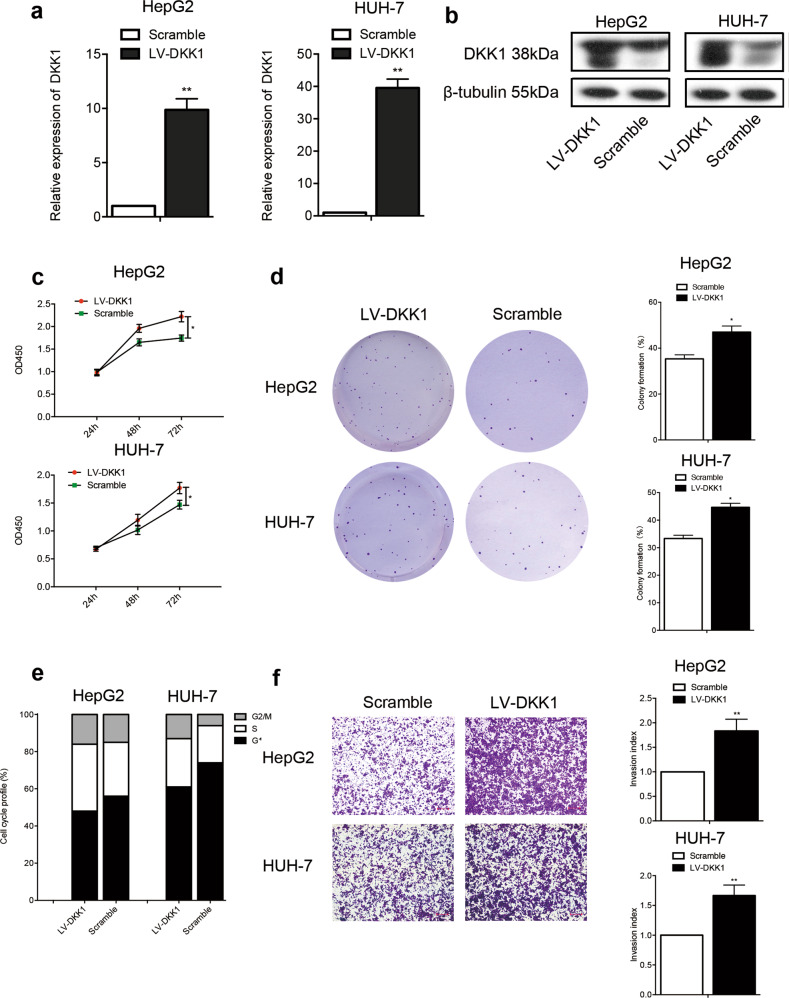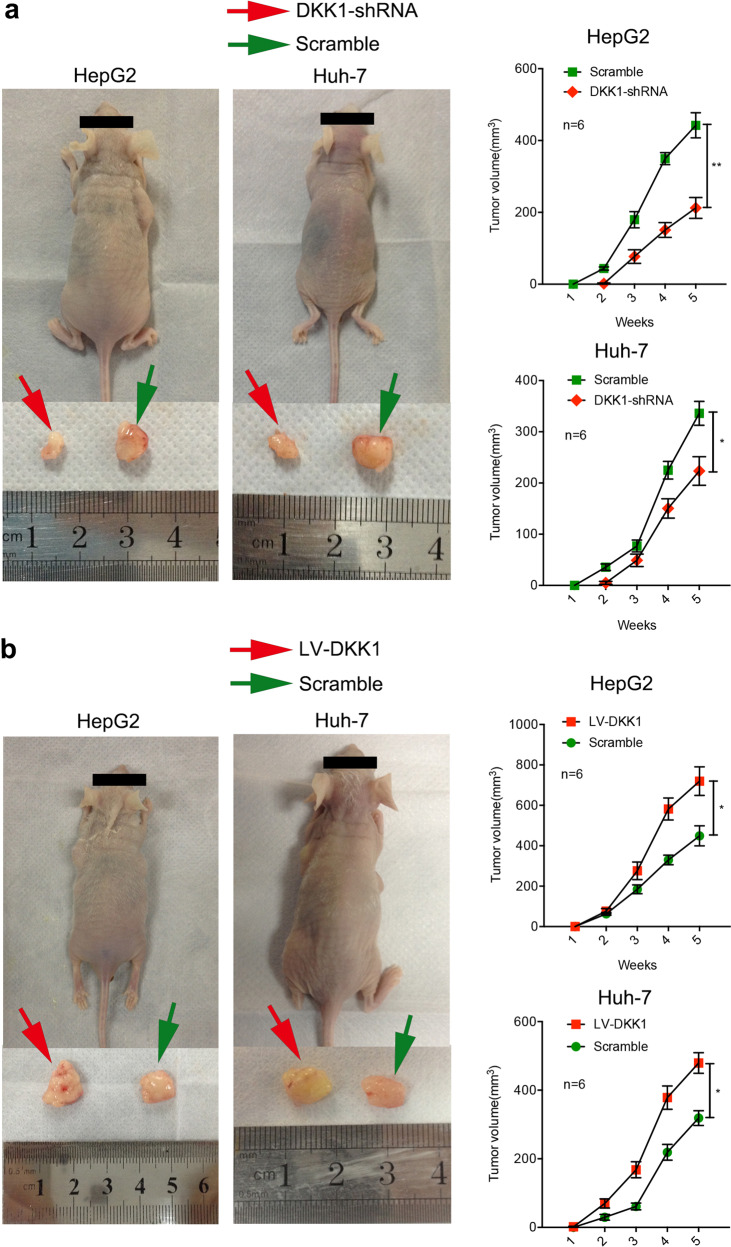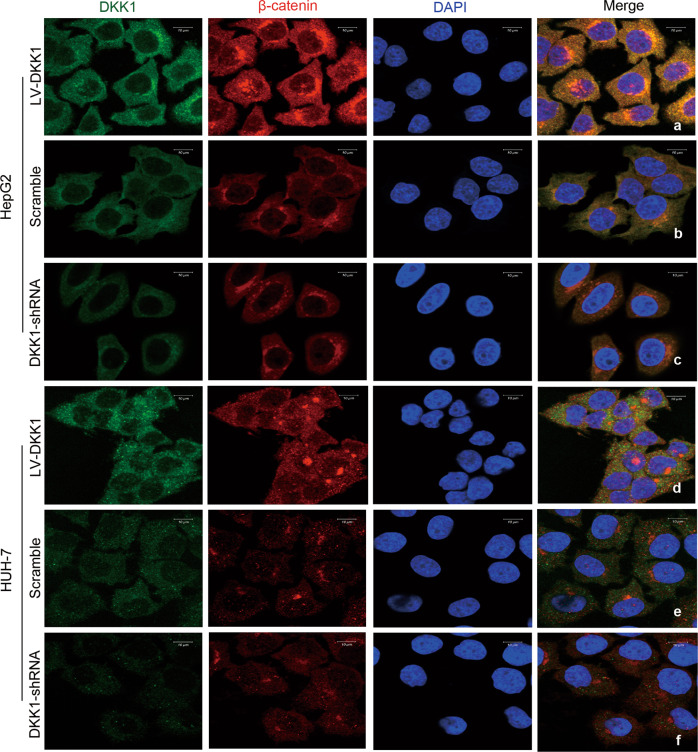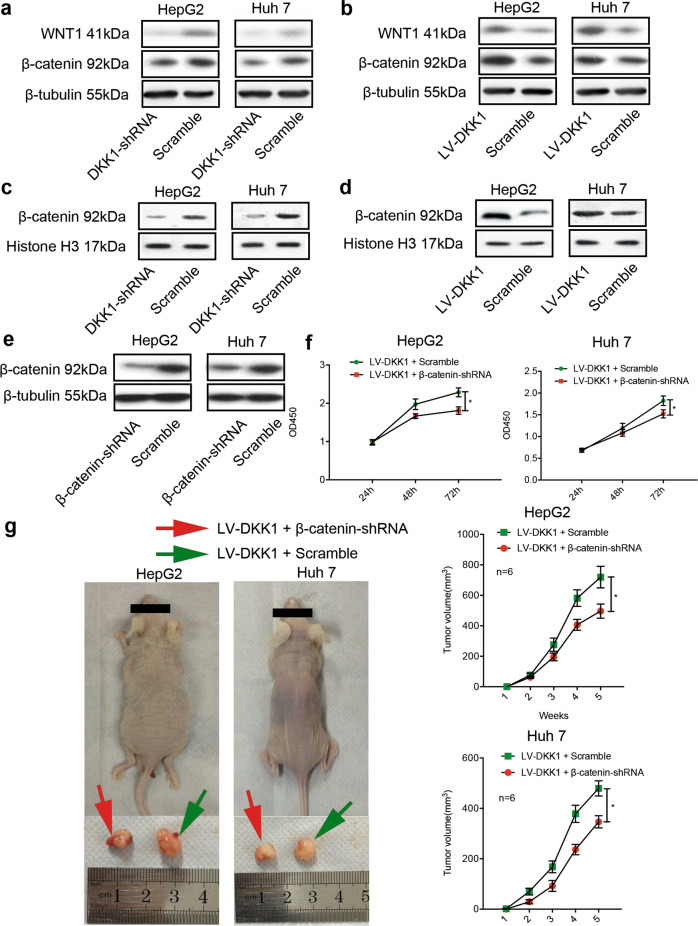Abstract
Dysregulation of dickkopf-related protein 1 (DKK1) expression has been reported in a variety of human cancers. We previously reported that DKK1 was upregulated in hepatocellular carcinoma (HCC). However, the role of DKK1 in HCC remains unclear. This study aimed to investigate the clinical significance and biological functions of DKK1 in HCC. The expression of DKK1 was examined in cirrhotic and HCC tissues by immunohistochemistry and quantitative real-time polymerase chain reaction (qRT-PCR). DKK1 was silenced or overexpressed in HCC cell lines, and in vitro and in vivo studies were performed. Immunohistochemistry revealed that DKK1 was weakly expressed in cirrhotic tissues (8/22, 36.4%) but upregulated in HCC tissues (48/53, 90.6%, cohort 1). Significant upregulation of DKK1 was observed in 57.6% (19/33, cohort 2) of HCC tissues by qRT-PCR, and the expression of DKK1 was associated with tumor size (P = 0.024) and tumor number (P = 0.019). Genetic depletion of DKK1 impaired the proliferation, colony-forming ability, invasion, and tumor formation of HCC cells (HepG2 and HUH-7). Conversely, forced expression of DKK1 increased the proliferation, colony-forming ability, and invasion of HepG2 and HUH-7 cells in vitro and enhanced tumor formation in vivo. Subsequent investigation revealed that the DKK1-mediated proliferation and tumorigenicity of HepG2 and HUH-7 cells is dependent on the Wnt/β-catenin signaling pathway. These findings indicate that DKK1 plays an oncogenic role in HCC by activating the Wnt/β-catenin signaling pathway.
Subject terms: Oncogenes, Cancer genetics
Introduction
Hepatocellular carcinoma (HCC) is the most frequent cause of cancer-related death worldwide.1 Curative procedures such as hepatectomy and liver transplantation can only be offered to approximately 1/3 of HCC patients and are associated with high recurrence rates.2 It is crucial to elucidate the underlying mechanism of HCC progression in order to develop therapeutic agents effective against HCC. Molecules that might be used as diagnostic/prognostic biomarkers or that inhibit HCC progression must be identified.3
Dickkopf-related protein 1 (DKK1) is a secreted protein that has been clearly identified as a direct inhibitor of Wnt/β-catenin signaling via the LRP5/6 coreceptor of Frizzled proteins.4–6 Accumulating evidence supports the involvement of DKK1 in human cancers. However, the role of DKK1 in tumor biology remains unclear.7 The expression of DKK1 was reported to be downregulated in colorectal carcinoma and lung cancer cells.8–10 Accumulation of Musashi RNA-binding protein 1 (MRP-1) in HCC cells significantly promotes proliferation, tumor formation, and cell cycle progression via silencing of DKK1.11 In contrast, upregulation of DKK1 has been found in a variety of human cancers, such as cholangiocarcinoma and pancreatic, esophageal, breast and kidney cancers.12–17 In the liver, the expression of DKK1 is downregulated in human HCC, and upregulation of DKK1 in HCC was able to inhibit the invasion of HCC cells.18 However, Chen and his colleagues19 reported that DKK1 enhances HCC cell invasion via the MMP-7 signaling pathway. Overexpression of DKK1 is associated with a poor prognosis in human HCC.20 In addition, DKK1 can be used as a serum biomarker for the diagnosis of HCC.21,22 It has been reported that HCC develops with increased frequency in hepatitis B virus surface antigen (HBsAg) transgenic mice.23 We previously reported that DKK1 was upregulated in HBsAg mouse liver tissues and in human HCC.24 Ultimately, the specific role of DKK1 in HCC remains controversial. In this study, the expression of DKK1 was examined in cirrhotic and HCC tissues by immunohistochemistry and quantitative real-time polymerase chain reaction (qRT-PCR). The biological function of DKK1 was investigated in HCC cell lines (HepG2 and HUH-7) using proliferation, invasion, cell cycle, colony formation, and xenograft tumor formation assays.
Materials and methods
Patient characteristics, immunohistochemistry, cell line establishment and cell culture, quantitative RT-PCR, western blot analysis, cell proliferation analyses, cell colony analyses, cell cycle analyses, cell invasion analyses, and subcutaneous xenograft assays in nude mice were performed as described in the Supplementary Materials and Methods.
Enzyme-linked immunosorbent assay
Enzyme-linked immunosorbent assay (ELISA) was performed to investigate the expression of DKK1 in the supernatant of HCC cells with a Human DKK1 ELISA Kit (Elabscience, China). Briefly, a 96-well plate was precoated with anti-human DKK1 antibodies, and supernatant samples were diluted with sample dilution buffer and added to the wells. The plate was incubated for 90 min at 37 °C. After DKK1 was bound to the wells by the immobilized antibody, the liquid was removed from each well, and biotinylated anti-human DKK1 antibody was immediately added to the wells and incubated at 37 °C for 1 h. After washing three times, HRP-conjugated streptavidin was added after removal of unbound biotinylated antibody. The wells were washed again, and TMB substrate solution was added. Finally, the absorbance was measured at 450 nm by using an ELISA plate reader. According to the standard curve generated by serial dilution of recombinant human DKK1, the level of soluble DKK1 in each supernatant sample was calculated.
Virus production and transduction
Lentiviral vectors (pGLV3/H1/GFP/Puro, pGHGV) expressing shRNA targeting human DKK1 or β-catenin or a negative control shRNA (listed in Supplementary Table 3) were purchased from GenePharma (Shanghai, China). All shRNA sequences were subjected to Basic Local Alignment Search Tool (BLAST) analysis to confirm the absence of homology to any additional known coding sequences. Full-length human DKK1 cDNA was PCR amplified, HA tagged, and inserted into the lentiviral vectors (pCDH/CMV/GFP/Puro, pCMGV) upstream of the internal ribosome entry (IRES) site. The DKK1 fragment was then isolated by NotI digestion and inserted into a DKK1 retroviral vector (pCMGV/DKK1). HepG2 and HUH-7 cells were infected with the pGHGV/shRNA-DKK1, pGHGV/shRNA-β-catenin, pCMGV/DKK1, or pCMGV vectors after 10 population doublings, as previously described.25 After puromycin selection, loss or gain of DKK1 or β-catenin were confirmed by qRT-PCR and western blot analysis, and stable cell lines were established.
Confocal microscopy assay
HepG2 and HUH-7 cells were grown to 50% confluence on glass coverslips in a 24-well plate. Following treatment, cells were fixed with 4% PFA, washed twice with PBS, and blocked for 30 min in PBS containing 10% goat serum and 0.1% saponin (DSP). Primary antibodies specific for DKK1 and β-catenin in DSP were added simultaneously for 2 h at room temperature. After washing three times with PBS, secondary antibodies in DSP were added for 2 h at room temperature. Coverslips were washed again three times with PBS and were then mounted on slides with DAPI Slow Fade. Representative images were acquired on a Leica TCS SP5 confocal microscope with an oil immersion objective at ×60magnification. Representative images are shown as enhanced using ImageJ software. The primary antibodies and secondary antibodies are listed in Supplementary Table 1.
TCF/LEF reporter assay
HepG2 and HUH-7 cells were plated at a density of 2 × 104 cells/well in 48-well plates and transfected with pGL3-blast or pGL3-LEF/TCF (purchased from MssBio, Guangzhou) using LipofectamineTM 3000 according to the manufacturer’s protocol. Luciferase activity was assessed using a Dual-Luciferase Reporter Assay system (Promega, Madison, WI, USA) according to the manufacturer’s instructions. The primer sequences used for amplification of TCF/LEF are shown in Supplementary Table 4.
Statistics
All statistical analyses were performed using SPSS for Windows (version 17.0; SPSS, Chicago, IL, USA). All experiments with cultured cells were carried out independently at least three times in experimental triplicate. All data are expressed as the means ± standard deviations (SDs) unless otherwise indicated. We determined the significance of differences in the human HCC data using Fisher’s exact test, in the in vitro data using Student’s t-test, and in the in vivo data using the Mann–Whitney U-test. In all cases, P values of <0.05 were considered statistically significant.
Results
DKK1 expression is upregulated in human HCC tissues
Immunohistochemistry revealed positive staining for the DKK1 protein in the cytoplasm of tumor cells. In general, DKK1 was weakly expressed (DKK1−, 14/22, 63.6%; DKK1+, 8/22, 36.4%) in 22 human cirrhotic tissues (Fig. 1a, b). In contrast, upregulated DKK1 expression (DKK1++ or +++) was observed in 48 of 53 human HCC tumor samples (90.6%) (Fig. 1c, d), while weak DKK1 expression (DKK1− or +) was found in the other five human HCC tumor samples (9.4%). qRT-PCR was performed to investigate the expression of DKK1 in 33 paired HCC and corresponding peritumoral tissues. As shown in Fig. 1e, significant upregulation of DKK1 was found in 57.6% (19/33, cohort 2) of the HCC tissue specimens compared with the corresponding peritumoral tissue specimens. These findings indicate that DKK1 may participate in human HCC progression.
Fig. 1.
DKK1 expression is increased in HCC tissues. The expression of DKK1 in human liver tissues was evaluated by immunohistochemistry and qRT-PCR. The results revealed weak expression (DKK1− or +) in 22 of 22 human cirrhotic tissue samples (a, b). Upregulated DKK1 expression (DKK1++ or +++) was observed in 48 of 53 human HCC tumor samples (c, d). Scale bar = 100 μm. Thirty-three pairs of fresh HCC and corresponding peritumoral liver tissues were used for qRT-PCR analysis (e)
HCC-related DKK1 expression is associated with tumor size and number
As shown in Table 1, qRT-PCR revealed that upregulated DKK1 expression was correlated with tumor size (P = 0.024) and tumor number (P = 0.019). However, DKK1 expression was not correlated with age (P = 0.116), sex (P = 0.142), capsular invasion (P = 0.292), portal vein tumor thrombi (P = 1.000), bile duct tumor thrombi (P = 0.424), lymphatic metastasis (P = 1.000), tumor stage (P = 0.238), histological grade (P = 0.531), serum alpha fetoprotein level (P = 1.000), serum CA19-9 level (P = 0.698), serum CA125 level (P = 0.707), or extrahepatic metastasis (P = 0.620).
Table 1.
Clinicopathologic data of 33 Hepatocellular carcinoma patients
| Characteristics | N | Group | P value | |
|---|---|---|---|---|
| DKK1 up |
DKK1 down |
|||
| Age (years) | 0.166 | |||
| ≤50 | 17 | 12 | 5 | |
| >50 | 16 | 7 | 9 | |
| Sex | 0.142 | |||
| Male | 31 | 17 | 14 | |
| Female | 2 | 2 | 0 | |
| Capsular invasion | 0.296 | |||
| Yes | 16 | 11 | 5 | |
| No | 17 | 8 | 9 | |
| Portal vein tumor thrombi | 1.000 | |||
| Yes | 13 | 8 | 5 | |
| No | 20 | 11 | 9 | |
| Bile duct tumor thrombi | 0.424 | |||
| Yes | 1 | 0 | 1 | |
| No | 32 | 19 | 13 | |
| Lymphatic metastasis | 1.000 | |||
| Yes | 11 | 6 | 5 | |
| No | 22 | 13 | 9 | |
| Metastasis | 0.620 | |||
| Yes | 4 | 3 | 1 | |
| No | 29 | 16 | 13 | |
| Tumor size (cm) | 0.024 | |||
| ≤5 | 11 | 3 | 8 | |
| >5 | 22 | 16 | 6 | |
| Tumor number | 0.019 | |||
| Single | 24 | 17 | 7 | |
| Multiple | 9 | 2 | 7 | |
| Tumor stage (UICC, 2010) | 0.238 | |||
| I + II | 8 | 3 | 5 | |
| III + IV | 25 | 16 | 9 | |
| Histological grade | 0.531 | |||
| G1 + G2 | 17 | 9 | 8 | |
| G3 + G4 | 16 | 10 | 6 | |
| HBsAg | 1.000 | |||
| Positive | 27 | 5 | 22 | |
| Negative | 10 | 1 | 9 | |
| Serum AFP (ng/ml) | 1.000 | |||
| ≤25 | 6 | 4 | 2 | |
| >25 | 27 | 15 | 12 | |
| CA199 (μl/ml) | 0.698 | |||
| >35 | 9 | 6 | 3 | |
| ≤35 | 24 | 13 | 11 | |
| CA125 (μl/ml) | 0.707 | |||
| >35 | 10 | 5 | 5 | |
| ≤35 | 23 | 14 | 9 | |
Compared via the chi-square test (Fisher’s exact test)
Transfection of DKK1-shRNA inhibits the proliferation, colony-forming ability, cell cycle progression, and invasion of HepG2 and HUH-7 cells in vitro
qRT-PCR and western blotting were performed to analyze the expression levels of DKK1 in DKK1-short hairpin RNA (shRNA) HCC cells (HepG2 and HUH-7). As shown in Fig. 2a, b, DKK1 was effectively and functionally suppressed by DKK1-shRNA in the evaluated HepG2 and HUH-7 cells. To verify that DKK1 was functionally silenced by the shRNA, we utilized ELISA to measure the expression levels of DKK1 in the supernatant of HCC cells. The ELISA results revealed that the DKK1 level was decreased in the supernatant of cultured stable DKK1-shRNA HepG2 and HUH-7 cells (Supplementary Fig. 1a, b). We further examined whether decreased DKK1 expression affected the biological activities of HepG2 and HUH-7 cells. The CCK-8 (Cell Counting Kit-8) assay results revealed that downregulation of DKK1 by DKK1-shRNA significantly inhibited the proliferation of HepG2 and HUH-7 cells (Fig. 2c). The colony formation assay results revealed that fewer colonies were found in DKK1-shRNA-treated HepG2 and HUH-7 cells than in the corresponding control cells (Fig. 2d). In addition, the FACS analysis-based cell cycle progression assay results revealed that DKK1 suppression decreased the number of HepG2 and HUH-7 cells in the S phase (Fig. 2e). The cell invasion assay results showed that the number of HepG2 and HUH-7 cells that migrated through the Transwell filter was markedly lower in the DKK1-shRNA group than in the control group (Fig. 2f). Collectively, these data indicate that suppression of DKK1 not only inhibits the proliferation but also decreases the invasion of HepG2 and HUH-7 cells in vitro.
Fig. 2.
Transfection of DKK1-shRNA suppresses the proliferation, colony-forming ability, cell cycle progression, and invasion of HepG2 and HUH-7 cells in vitro. Short hairpin RNA (shRNA)-DKK1 was transfected into HepG2 and HUH-7 cells. The stable cell lines were established after puromycin selection. Changes in DKK1 mRNA expression were determined by qRT-PCR (a). The levels of DKK1 were determined by western blot analysis (b). Transfection of DKK1-shRNA suppressed the proliferation (c), colony-forming ability (d), cell cycle progression (e), and invasion (f) of HepG2 and HUH-7 cells in vitro. *P < 0.05, **P < 0.01
Forced expression of DKK1 increases the proliferation, colony-forming ability, cell cycle progression, and invasion of HepG2 and HUH-7 cells in vitro
To investigate the effects of DKK1 on HCC cells, pCMGV/DKK1-derived retroviruses were used to transduce HepG2 and HUH-7 cells to establish HCC cell lines with stable forced expression of DKK1. The qRT-PCR and western blot analysis results revealed that DKK1 expression was effectively and functionally induced in HepG2 and HUH-7 cells compared with control cells (Fig. 3a, b). In addition, the ELISA results showed that the DKK1 level was increased in the supernatants of cultured HepG2 and HUH-7 cells with stable forced expression of DKK1 (Supplementary Fig. 1a, b). The results of CCK-8 and colony formation assays revealed that forced expression of DKK1 significantly increased the proliferation (Fig. 3c) and colony-forming ability (Fig. 3d) of both HepG2 and HUH-7 cells compared with the corresponding control cells. Furthermore, the cell cycle distribution analysis results showed a significant increase in the number of cells in the S phase after forced expression of DKK1 in HepG2 and HUH-7 cells (Fig. 3e). Moreover, the number of HepG2 and HUH-7 cells that migrated through the Transwell filter was markedly higher in the forced DKK1 expression group than in the control group (Fig. 3f). Taken together, these data suggest that forced expression of DKK1 enhances the proliferative and invasive properties of HepG2 and HUH-7 cells in vitro.
Fig. 3.
Stable forced expression of DKK1 enhances the proliferation, colony-forming ability, cell cycle progression, and invasion of HepG2 and HUH-7 cells in vitro. HepG2 and HUH-7 cells with forced expression of DKK1 were established via a DKK1 lentiviral vector (LV-DKK1). Changes in DKK1 mRNA expression were determined by qRT-PCR (a). The protein levels of DKK1 were determined by western blot analysis (b). Forced expression of DKK1 enhanced the proliferation (c), colony-forming ability (d), cell cycle progression (e), and invasion (f) of HepG2 and HUH-7 cells in vitro. *P < 0.05, **P < 0.01
Forced expression of DKK1 enhances the tumorigenicity of HepG2 and HUH-7 cells in vivo
Because the in vitro studies suggested that DKK1 plays a regulatory role in HepG2 and HUH-7 cell proliferation and invasion, the biological significance of these results was further evaluated in an in vivo model of HCC. To this end, a xenograft tumor formation assay was performed to investigate the effect of DKK1. As shown in Fig. 4a, downregulation of DKK1 impaired the tumorigenicity of HepG2 and HUH-7 cells in nude mice. Scrambled shRNA-treated HepG2 and HUH-7 cells generated large tumors on the right flanks of the nude mice (green arrow). Smaller tumors were observed on the left flanks of mice injected with DKK1-shRNA-treated HepG2 and HUH-7 cells (red arrow). Forced expression of DKK1 in HepG2 and HUH-7 cells led to significantly enhanced in vivo growth of the tumors on the left flanks of the nude mice (red arrow) compared with the growth of the tumors from control cells on the right flanks of the nude mice (green arrow) (Fig. 4b). These data corroborate the in vitro observations and support the idea that forced expression of DKK1 enhances the tumorigenicity of HepG2 and HUH-7 cells in vivo, indicating that DKK1 might function as an oncogene.
Fig. 4.
Forced expression of DKK1 promotes tumor formation by HepG2 and HUH-7 cells in vivo. Compared with control conditions, downregulation of DKK1 in HepG2 and HUH-7 cells significantly diminished in vivo tumor formation. Control HepG2 and HUH-7 cells transfected with scrambled shRNA generated large tumors on the right flanks of nude mice (green arrow), while smaller tumors were observed on the left flanks of mice injected with DKK1-shRNA-transfected HepG2 and HUH-7 cells (red arrow) (a, left panel). The volumes of tumors in the recipient mice are shown (a, right panel). Forced expression of DKK1 in HCC cells produced significantly enhanced in vivo growth of tumors on the left flanks of the nude mice (red arrow) compared with tumors on the right flanks of mice injected with control cells (green arrow) (b, left panel); the volumes of tumors in the recipient mice are shown (b, right panel). *P < 0.05
The Wnt/β-catenin signaling pathway is activated by DKK1 in HCC cell lines
Next, we investigated a potential mechanism underlying the effects of DKK1 on HCC cell proliferation and tumor formation. DKK1 is well established as a key regulator of the Wnt/β-catenin signaling pathway.7 Increased expression of DKK1 is associated with cytoplasmic/nuclear β-catenin accumulation in HCC patients.20 Therefore, we investigated whether DKK1 can activate the Wnt/β-catenin signaling pathway. Fluorescently labeled anti-DKK1 and anti-β-catenin antibodies were used for confocal microscopy analysis. Confocal microscopy revealed that forced expression of DKK1 in HepG2 and HUH-7 cells increased the nuclear expression of β-catenin (Fig. 5a, d) in vitro. In contrast, downregulation of DKK1 in HepG2 and HUH-7 cells impaired the nuclear expression of β-catenin (Figs. 5 and 2c, f) in vitro. To detect the activity of the Wnt/β-catenin signaling pathway, we used a luciferase reporter assay. HCC cells were transfected with pGL3-TCF/LEF for the Wnt/β-catenin signaling pathway assessment. As shown in Supplementary Fig. 2a,b, suppression of DKK1 in HepG2 and HUH-7 cells decreased the luciferase activity, and vice versa. Additionally, the western blot analysis results revealed that suppression of DKK1 in HepG2 and HUH-7 cells decreased the protein expression of WNT1 and β-catenin (Fig. 6a). Moreover, forced expression of DKK1 enhanced WNT1 and β-catenin expression in HepG2 and HUH-7 cells compared with the corresponding control cells (Fig. 6b). Subsequent investigation revealed that forced expression of DKK1 enhanced the nuclear expression of β-catenin (Fig. 6c, d). These findings indicated that DKK1 promotes β-catenin nuclear translocation and that the Wnt/β-catenin signaling pathway is activated by DKK1 in human HCC cell lines. WNT1 and β-catenin may be important downstream targets of the DKK1 cascade.
Fig. 5.
The Wnt/β-catenin signaling pathway is activated by DKK1 in HepG2 and HUH-7 cells. The expression of DKK1 and β-catenin in HCC cells was investigated by confocal microscopy. Overexpression of DKK1 in HepG2 and HUH-7 cells increased the nuclear accumulation of β-catenin (a, d, white arrows) compared with that in the corresponding control cells (b). However, downregulation of DKK1 in HepG2 and HUH-7 cells did not obviously inhibit the nuclear accumulation of β-catenin (c, f) compared with that in the corresponding control cells (e)
Fig. 6.
DKK1-mediated proliferation and tumor formation are dependent on the Wnt/β-catenin signaling pathway in human HepG2 and HUH-7 cells. The protein levels of WNT1, β-catenin, and nuclear β-catenin in HepG2 and HUH-7 cells were measured by western blot analysis. Suppression of DKK1 in these cells decreased the expression of WNT1 and β-catenin (a) and the accumulation of nuclear β-catenin (c). Forced expression of DKK1 enhanced the expression of WNT1 and β-catenin (b) and the accumulation of nuclear β-catenin (d) in these cells compared with the corresponding control cells. β-Catenin-shRNA lentiviral vectors were used to deplete β-catenin in DKK1-overexpressing HCC cells, and β-catenin depletion was then confirmed by western blotting (e). Knockdown of β-catenin significantly inhibited the proliferation (f) and tumorigenicity (g, left panel) of DKK1-overexpressing HCC cells. The volumes of tumors in the recipient mice are shown (g, right panel). *P < 0.05
Downregulation of β-catenin impaired the proliferation and tumorigenicity of HCC cells with forced expression of DKK1
Deregulation of the Wnt/β-catenin signaling pathway is a hallmark of cancers, including HCC. β-Catenin is a major functional protein in the Wnt/β-catenin signaling pathway.26–28 However, whether β-catenin is involved in formation of tumors by HCC cells with forced expression of DKK1 (DKK1High HCC cells) remains unclear. To investigate the role of β-catenin, β-catenin-shRNA lentiviral vectors were used to deplete β-catenin expression in DKK1High HepG2 and HUH-7 cells and establish stable β-cateninLowDKK1High HepG2 and HUH-7 cell lines (Fig. 6e). As shown in Fig. 6f, β-catenin knockdown in DKK1High HCC cells markedly inhibited proliferation compared with that under control conditions in vitro. Consistent with this result, β-cateninLowDKK1High HepG2 and HUH-7 cells exhibited significantly diminished in vivo tumor formation (red arrow) compared with DKK1-DKK1High HepG2 and HUH-7 cells (green arrow) (Fig. 6g) in vivo. These findings indicate that DKK1 enhances proliferation and tumor formation through β-catenin in HCC cells.
Discussion
We previously reported that DKK1 was overexpressed in HCC.24 However, the specific role of DKK1 in HCC remains to be ascertained. It has been reported that DKK1 promotes HCC cell invasion and that increased expression of DKK1 is associated with poor prognosis in HCC patients.19,20 These data suggest that DKK1 may be involved in the progression of HCC. Herein, we demonstrated that DKK1 is upregulated in HCC tissues and is associated with larger tumor sizes and multiple tumors in patients with HCC. These findings indicate that DKK1 may participate in the progression of HCC. Additionally, depletion of DKK1 in HCC cells impaired cell proliferation, colony formation, cell cycle progression, and cell invasion abilities in vitro. In contrast, forced expression of DKK1 dramatically enhanced the proliferation, colony-forming ability, cell cycle progression, and invasion of HCC cells. Taken together, these data suggest that DKK1 plays a vital role in the proliferation and invasion of HCC cells in vitro.
The function of DKK1 in HCC tumor formation, has not been examined to date. Here, the results of the in vivo assays provide the first evidence that implantation of HepG2 and HUH-7 cells with forced expression of DKK1 into nude mice results in enhanced tumor formation, indicating that DKK1 plays a significant role in the tumorigenicity of HCC cells in vivo. Collectively, these results indicate that DKK1 functions as a tumor oncogene in HCC. In the present study, the possible mechanism by which DKK1 mediates proliferation and tumor formation in HCC was investigated. WNT-induced signaling, which is frequently involved in cancer progression, can be suppressed by DKK1.6,29–31 In addition, DKK1 has been shown to be activated during the progression of multiple tumors, including HCCs.7 Moreover, Yu et al.20 reported that increased expression of DKK1 is associated with cytoplasmic/nuclear β-catenin accumulation in HCC patients. It seems likely that DKK1 is involved in the regulation of Wnt/β-catenin in HCC cells. Here, we found that the expression levels of WNT1 and β-catenin were dramatically increased in HepG2 and HUH-7 cells with forced expression of DKK1. Knockdown of DKK1 in HCC cells by DKK1-shRNA dramatically impaired the protein expression of WNT1 and β-catenin. Moreover, deletion of DKK1 decreased TCF/LEF activity. Most importantly, the findings from confocal microscopy and western blot analysis also revealed that forced expression of DKK1 promotes β-catenin nuclear translocation in HepG2 and HUH-7 cells. Taken together, these data suggest that the Wnt/β-catenin signaling pathway is activated by DKK1 in HCC cells in vitro. WNT1 and β-catenin may be important downstream targets of DKK1.
β-Catenin is the key functional protein in the Wnt/β-catenin signaling pathway.26,32 It has been reported that β-catenin translocates from the cytoplasm to the nucleus and is essential for tumorigenesis.33,34 However, whether DKK1 is involved in the regulation of β-catenin in HCC cells is unclear. Thus, β-catenin-shRNA lentiviral vectors were used to deplete β-catenin expression in HepG2 and HUH-7 cells with forced expression of DKK1. We found that knockdown of β-catenin markedly inhibited the in vitro proliferation and in vivo tumorigenicity of HCC cells with forced expression of DKK1 compared with the corresponding control cells. These findings imply that DKK1 may enhance the proliferation and tumorigenicity of HCC cells through β-catenin.
In conclusion, DKK1 contributes to HCC tumorigenesis by activating the Wnt/β-catenin signaling pathway, thus providing us with a potential therapeutic option for HCC in clinical practice.
Supplementary information
Acknowledgements
This work was supported by The Special Research Foundation of the National Nature Science Foundation of China (81972262, 81972255, 81772597, 81702904), the Guangdong Natural Science Foundation (2018A030313645, 2017A030311002, 2015A030313101); the Guangdong Science and Technology Foundation (2016A020215199, 2017A020215196); the Science and Technology Program of Guangzhou, China (201607010111); the Pearl River S&T Nova Program of Guangzhou, China (201610010022); the Fundamental Research Funds for the Central Universities (17ykpy44, 18ykpy22); Grant [2013]163 from the Key Laboratory of Malignant Tumor Molecular Mechanism and Translational Medicine of the Guangzhou Bureau of Science and Information Technology; Grant KLB09001 from the Key Laboratory of Malignant Tumor Gene Regulation and Target Therapy of Guangdong Higher Education Institutes; and grants from the Guangdong Science and Technology Department (2015B050501004, 2017B030314026).
Author contributions
R.Z., H.-M.L. and C.L. designed this research. R.Z. and W.-R.W. conducted the experiments and analyzed the data; W.-R.W., L.-B.X., X.-D.S., X.-H.Y. and R.B. interpreted the results; R.Z., C.L. and R.B. drafted the manuscript with contributions from all authors; and R. Z. and W.-R.W revised the paper.
Competing interests
The authors declare no competing interests.
Footnotes
This article has been retracted. Please see the retraction notice for more detail:https://doi.org/10.1038/s41392-023-01475-8
These authors contributed equally: Rui Zhang, Hao-Ming Lin, Ruth Broering
Change history
5/5/2023
This article has been retracted. Please see the Retraction Notice for more detail: 10.1038/s41392-023-01475-8
Contributor Information
Wen-rui Wu, Email: doctorrui@126.com.
Chao Liu, Email: mdliuchao@hotmail.com.
Supplementary information
The online version of this article (10.1038/s41392-019-0082-5) contains supplementary material, which is available to authorized users.
References
- 1.Sangiovanni A, et al. Increased survival of cirrhotic patients with a hepatocellular carcinoma detected during surveillance. Gastroenterology. 2004;126:1005–1014. doi: 10.1053/j.gastro.2003.12.049. [DOI] [PubMed] [Google Scholar]
- 2.Llovet M, Burroughs A, Bruix J. Hepatocellular carcinoma. Lancet. 2003;362:1907–1917. doi: 10.1016/S0140-6736(03)14964-1. [DOI] [PubMed] [Google Scholar]
- 3.Kimhofer T, et al. Proteomic and metabonomic biomarkers for hepatocellular carcinoma: a comprehensive review. Br. J. Cancer. 2015;112:1141–1156. doi: 10.1038/bjc.2015.38. [DOI] [PMC free article] [PubMed] [Google Scholar]
- 4.Moustakas A, Heldin CH. Signaling networks guiding epithelial-mesenchymal transitions during embryogenesis and cancer progression. Cancer Sci. 2007;98:1512–1520. doi: 10.1111/j.1349-7006.2007.00550.x. [DOI] [PMC free article] [PubMed] [Google Scholar]
- 5.Glinka A, et al. Dickkopf-1 is a member of a new family of secreted proteins and functions in head induction. Nature. 1998;391:357–362. doi: 10.1038/34848. [DOI] [PubMed] [Google Scholar]
- 6.Semenov MV, et al. Head inducer Dickkopf-1 is a ligand for Wnt coreceptor LRP6. Curr. Biol. 2001;11:951–961. doi: 10.1016/S0960-9822(01)00290-1. [DOI] [PubMed] [Google Scholar]
- 7.Menezes ME, et al. Dickkopf1: a tumor suppressor or metastasis promoter? Int. J. Cancer. 2012;130:1477–1483. doi: 10.1002/ijc.26449. [DOI] [PMC free article] [PubMed] [Google Scholar]
- 8.Liu Z, et al. Dickkopf-1 expression is down-regulated during the colorectal adenoma-carcinoma sequence and correlates with reduced microvessel density and VEGF expression. Histopathology. 2015;67:158–166. doi: 10.1111/his.12474. [DOI] [PubMed] [Google Scholar]
- 9.Qi L, et al. Dickkopf-1 inhibits epithelial-mesenchymal transition of colon cancer cells and contributes to colon cancer suppression. Cancer Sci. 2012;103:828–835. doi: 10.1111/j.1349-7006.2012.02222.x. [DOI] [PMC free article] [PubMed] [Google Scholar]
- 10.Xiang XJ, et al. Differential expression of Dickkopf-1 among non-small cell lung cancer cells. Mol. Med. Rep. 2015;12:1935–1940. doi: 10.3892/mmr.2015.3654. [DOI] [PubMed] [Google Scholar]
- 11.Chen K, et al. Musashi1 regulates survival of hepatoma cell lines by activation of Wnt signalling pathway. Liver Int. 2015;35:986–998. doi: 10.1111/liv.12458. [DOI] [PubMed] [Google Scholar]
- 12.Guo CC, et al. Decreased expression of Dkk1 and Dkk3 in human clear cell renal cell carcinoma. Mol. Med. Rep. 2014;9:2367–2373. doi: 10.3892/mmr.2014.2077. [DOI] [PubMed] [Google Scholar]
- 13.Han SX, et al. Serum dickkopf-1 is a novel serological biomarker for the diagnosis and prognosis of pancreatic cancer. Oncotarget. 2015;6:19907–19917. doi: 10.18632/oncotarget.4529. [DOI] [PMC free article] [PubMed] [Google Scholar]
- 14.Rachner TD, et al. Dickkopf-1 is regulated by the mevalonate pathway in breast cancer. Breast Cancer Res. 2014;16:R20. doi: 10.1186/bcr3616. [DOI] [PMC free article] [PubMed] [Google Scholar]
- 15.Shi RY, et al. High expression of Dickkopf-related protein 1 is related to lymphatic metastasis and indicates poor prognosis in intrahepatic cholangiocarcinoma patients after surgery. Cancer. 2013;119:993–1003. doi: 10.1002/cncr.27788. [DOI] [PubMed] [Google Scholar]
- 16.Yamabuki T, et al. Dikkopf-1 as a novel serologic and prognostic biomarker for lung and esophageal carcinomas. Cancer Res. 2007;67:2517–2525. doi: 10.1158/0008-5472.CAN-06-3369. [DOI] [PubMed] [Google Scholar]
- 17.Forget MA, et al. The Wnt pathway regulator DKK1 is preferentially expressed in hormone-resistant breast tumours and in some common cancer types. Br. J. Cancer. 2007;96:646–653. doi: 10.1038/sj.bjc.6603579. [DOI] [PMC free article] [PubMed] [Google Scholar]
- 18.Qin X, et al. Proliferation and migration mediated by Dkk-1/Wnt/beta-catenin cascade in a model of hepatocellular carcinoma cells. Transl. Res. 2007;150:281–294. doi: 10.1016/j.trsl.2007.06.005. [DOI] [PubMed] [Google Scholar]
- 19.Chen L, et al. DKK1 promotes hepatocellular carcinoma cell migration and invasion through beta-catenin/MMP7 signaling pathway. Mol. Cancer. 2013;12:157. doi: 10.1186/1476-4598-12-157. [DOI] [PMC free article] [PubMed] [Google Scholar]
- 20.Yu B, et al. Elevated expression of DKK1 is associated with cytoplasmic/nuclear beta-catenin accumulation and poor prognosis in hepatocellular carcinomas. J. Hepatol. 2009;50:948–957. doi: 10.1016/j.jhep.2008.11.020. [DOI] [PubMed] [Google Scholar]
- 21.Shen Q, et al. Serum DKK1 as a protein biomarker for the diagnosis of hepatocellular carcinoma: a large-scale, multicentre study. Lancet Oncol. 2012;13:817–826. doi: 10.1016/S1470-2045(12)70233-4. [DOI] [PubMed] [Google Scholar]
- 22.Ge T, et al. Diagnostic values of alpha-fetoprotein, dickkopf-1, and osteopontin for hepatocellular carcinoma. Med. Oncol. 2015;32:59. doi: 10.1007/s12032-014-0367-z. [DOI] [PubMed] [Google Scholar]
- 23.Chisari FV, et al. Molecular pathogenesis of hepatocellular carcinoma in hepatitis B virus transgenic mice. Cell. 1989;59:1145–1156. doi: 10.1016/0092-8674(89)90770-8. [DOI] [PubMed] [Google Scholar]
- 24.Zhang R, et al. Hepatic expression of oncogenes Bmi1 and Dkk1 is up-regulated in hepatitis B virus surface antigen-transgenic mice and can be induced by treatment with HBV particles or lipopolysaccharides in vitro. Int. J. Cancer. 2017;141:354–363. doi: 10.1002/ijc.30742. [DOI] [PubMed] [Google Scholar]
- 25.Zhang R, et al. Dysregulation of Bmi1 promotes malignant transformation of hepatic progenitor cells. Oncogenesis. 2016;5:e203. doi: 10.1038/oncsis.2016.6. [DOI] [PMC free article] [PubMed] [Google Scholar]
- 26.Whittaker S, Marais R, Zhu AX. The role of signaling pathways in the development and treatment of hepatocellular carcinoma. Oncogene. 2010;29:4989–5005. doi: 10.1038/onc.2010.236. [DOI] [PubMed] [Google Scholar]
- 27.White BD, Chien AJ, Dawson DW. Dysregulation of Wnt/beta-catenin signaling in gastrointestinal cancers. Gastroenterology. 2012;142:219–232. doi: 10.1053/j.gastro.2011.12.001. [DOI] [PMC free article] [PubMed] [Google Scholar]
- 28.Thompson MD, Monga SP. WNT/beta-catenin signaling in liver health and disease. Hepatology. 2007;45:1298–1305. doi: 10.1002/hep.21651. [DOI] [PubMed] [Google Scholar]
- 29.Gonzalez-Sancho JM, et al. The Wnt antagonist DICKKOPF-1 gene is a downstream target of beta-catenin/TCF and is downregulated in human colon cancer. Oncogene. 2005;24:1098–1103. doi: 10.1038/sj.onc.1208303. [DOI] [PubMed] [Google Scholar]
- 30.Sikandar S, et al. The class I HDAC inhibitor MGCD0103 induces cell cycle arrest and apoptosis in colon cancer initiating cells by upregulating Dickkopf-1 and non-canonical Wnt signaling. Oncotarget. 2010;1:596–605. doi: 10.18632/oncotarget.194. [DOI] [PMC free article] [PubMed] [Google Scholar]
- 31.Klaus A, Birchmeier W. Wnt signalling and its impact on development and cancer. Nat. Rev. cancer. 2008;8:387–398. doi: 10.1038/nrc2389. [DOI] [PubMed] [Google Scholar]
- 32.McCubrey JA, et al. GSK-3 as potential target for therapeutic intervention in cancer. Oncotarget. 2014;5:2881–2911. doi: 10.18632/oncotarget.2037. [DOI] [PMC free article] [PubMed] [Google Scholar]
- 33.Zhang N, et al. FoxM1 promotes beta-catenin nuclear localization and controls Wnt target-gene expression and glioma tumorigenesis. Cancer Cell. 2011;20:427–442. doi: 10.1016/j.ccr.2011.08.016. [DOI] [PMC free article] [PubMed] [Google Scholar]
- 34.Lee K, et al. eta-catenin nuclear translocation in colorectal cancer cells is suppressed by PDE10A inhibition, cGMP elevation, and activation of PKG. Oncotarget. 2016;7:5353–5365. doi: 10.18632/oncotarget.6705. [DOI] [PMC free article] [PubMed] [Google Scholar]
Associated Data
This section collects any data citations, data availability statements, or supplementary materials included in this article.



